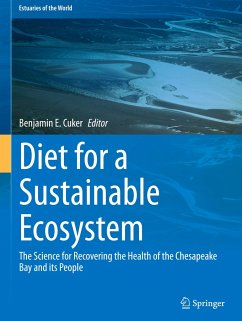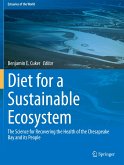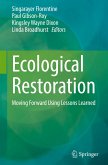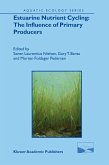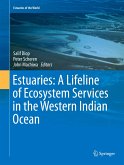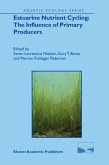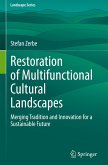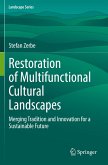Diet for a Sustainable Ecosystem
The Science for Recovering the Health of the Chesapeake Bay and its People
Herausgegeben:Cuker, Benjamin E.
Diet for a Sustainable Ecosystem
The Science for Recovering the Health of the Chesapeake Bay and its People
Herausgegeben:Cuker, Benjamin E.
- Gebundenes Buch
- Merkliste
- Auf die Merkliste
- Bewerten Bewerten
- Teilen
- Produkt teilen
- Produkterinnerung
- Produkterinnerung
This book explores a specific ecosystem in depth, in order to weave a story built on place and history. It incorporates the theme of a journey to help reveal the environment-human-health-food system-problem. While drawing on a historical approach stretching back to the American colonial era, it also incorporates more contemporary scientific findings. By crafting its story around a specific place, the book makes it easier for readers to relate to the content, and to subsequently use what they learn to better understand the role of food systems at the global scale.
Andere Kunden interessierten sich auch für
![Diet for a Sustainable Ecosystem Diet for a Sustainable Ecosystem]() Diet for a Sustainable Ecosystem154,99 €
Diet for a Sustainable Ecosystem154,99 €![Ecological Restoration Ecological Restoration]() Ecological Restoration44,99 €
Ecological Restoration44,99 €![Estuarine Nutrient Cycling: The Influence of Primary Producers Estuarine Nutrient Cycling: The Influence of Primary Producers]() Estuarine Nutrient Cycling: The Influence of Primary Producers116,99 €
Estuarine Nutrient Cycling: The Influence of Primary Producers116,99 €![Estuaries: A Lifeline of Ecosystem Services in the Western Indian Ocean Estuaries: A Lifeline of Ecosystem Services in the Western Indian Ocean]() Estuaries: A Lifeline of Ecosystem Services in the Western Indian Ocean77,99 €
Estuaries: A Lifeline of Ecosystem Services in the Western Indian Ocean77,99 €![Estuarine Nutrient Cycling: The Influence of Primary Producers Estuarine Nutrient Cycling: The Influence of Primary Producers]() Søren Laurentius Nielsen / Gary T. Banta / Morten Foldager Pedersen (eds.)Estuarine Nutrient Cycling: The Influence of Primary Producers121,99 €
Søren Laurentius Nielsen / Gary T. Banta / Morten Foldager Pedersen (eds.)Estuarine Nutrient Cycling: The Influence of Primary Producers121,99 €![Restoration of Multifunctional Cultural Landscapes Restoration of Multifunctional Cultural Landscapes]() Stefan ZerbeRestoration of Multifunctional Cultural Landscapes123,99 €
Stefan ZerbeRestoration of Multifunctional Cultural Landscapes123,99 €![Restoration of Multifunctional Cultural Landscapes Restoration of Multifunctional Cultural Landscapes]() Stefan ZerbeRestoration of Multifunctional Cultural Landscapes89,99 €
Stefan ZerbeRestoration of Multifunctional Cultural Landscapes89,99 €-
-
-
This book explores a specific ecosystem in depth, in order to weave a story built on place and history. It incorporates the theme of a journey to help reveal the environment-human-health-food system-problem. While drawing on a historical approach stretching back to the American colonial era, it also incorporates more contemporary scientific findings. By crafting its story around a specific place, the book makes it easier for readers to relate to the content, and to subsequently use what they learn to better understand the role of food systems at the global scale.
Produktdetails
- Produktdetails
- Estuaries of the World
- Verlag: Springer / Springer International Publishing / Springer, Berlin
- Artikelnr. des Verlages: 978-3-030-45480-7
- 1st edition 2020
- Seitenzahl: 444
- Erscheinungstermin: 11. August 2020
- Englisch
- Abmessung: 285mm x 215mm x 30mm
- Gewicht: 1318g
- ISBN-13: 9783030454807
- ISBN-10: 3030454800
- Artikelnr.: 58795689
- Herstellerkennzeichnung Die Herstellerinformationen sind derzeit nicht verfügbar.
- Estuaries of the World
- Verlag: Springer / Springer International Publishing / Springer, Berlin
- Artikelnr. des Verlages: 978-3-030-45480-7
- 1st edition 2020
- Seitenzahl: 444
- Erscheinungstermin: 11. August 2020
- Englisch
- Abmessung: 285mm x 215mm x 30mm
- Gewicht: 1318g
- ISBN-13: 9783030454807
- ISBN-10: 3030454800
- Artikelnr.: 58795689
- Herstellerkennzeichnung Die Herstellerinformationen sind derzeit nicht verfügbar.
Prof. Benjamin Cuker has studied arctic lakes, southern ponds and the Chesapeake Bay. His work on diversifying the aquatic science community garnered him a Pew Fellowship in Marine Conservation (1999) and awards from the Association for the Sciences of Limnology and Oceanography (1993, 2009). Having been a Professor of Marine and Environmental Science at Hampton University since 1988, he also knows the Chesapeake well as a cruising and racing sailor who won the "Down The Bay" race in 2014 and 2015.
Part I. Introduction and Background.- Introduction: Starting the Journey to a Sustainable Ecosystem and Healthy People.- The Bay and Its Watershed: A Voyage Back in Time.-
Scientific Concepts for Understanding the health of the Chesapeake Bay and its people.- Part II. Foundations of the Chesapeake Bay Food System and the Consequences of Over-Extraction.- The Algonquin Food System and how it Shaped the Ecosystem and Interactions with the English Colonists of the Chesapeake Bay.- A Fishing Trip: Exploiting and managing the commons of the Chesapeake Bay.- Menhaden, the Inedible Fish that Most Everyone Eats.- Blue Crabs: Beautiful Savory Swimmers of the Chesapeake Bay.- The Chesapeake Bay Oyster: Cobblestone to Keystone.- Passenger Pigeon and Waterfowl: Flights to Extinction and Not.- Part III. Industrial-chemical Agriculture Reshapes the Bay's Ecosystem.- The journey from Peruvian Guano to Artificial Fertilizer ends with too Much Nitrogen in the Chesapeake Bay.- Pesticides bring the War on Nature to The Chesapeake Bay.- Livestock and Poultry: the Other Colonists who Changed the Food System of the Chesapeake Bay.- Part IV. Consequences of and Alternatives to the Standard American Diet: Human and Ecosystem Health.- Instead of Eating Fish: the Health Consequences of Eating Seafood from the Chesapeake Bay Compared to Other Choices.- Sugar Twice Enslaves: Consequences for the People of the Chesapeake.- Eutrophication: Obesity of the Bay and its People.- Finishing the Journey: Urine and Feces as Misplaced Resources.- Plastic Food System Waste Travels Far but Never Goes Away.- Part V. Looking to the Future: Ecology, Economics, Ethics, and Policy for Restoring the Health of the Bay and its People.- A New Food System for The Chesapeake Bay Region and a Changing Climate.- An Organic-Based Food System: A Voyage Back and Forward in Time.- What Nature, Politics and Policy Demand of the Chesapeake Bay and its Food System.- Ethics and Economics of Building a Food System to Recover the Health of the Chesapeake Bay and its People.
Scientific Concepts for Understanding the health of the Chesapeake Bay and its people.- Part II. Foundations of the Chesapeake Bay Food System and the Consequences of Over-Extraction.- The Algonquin Food System and how it Shaped the Ecosystem and Interactions with the English Colonists of the Chesapeake Bay.- A Fishing Trip: Exploiting and managing the commons of the Chesapeake Bay.- Menhaden, the Inedible Fish that Most Everyone Eats.- Blue Crabs: Beautiful Savory Swimmers of the Chesapeake Bay.- The Chesapeake Bay Oyster: Cobblestone to Keystone.- Passenger Pigeon and Waterfowl: Flights to Extinction and Not.- Part III. Industrial-chemical Agriculture Reshapes the Bay's Ecosystem.- The journey from Peruvian Guano to Artificial Fertilizer ends with too Much Nitrogen in the Chesapeake Bay.- Pesticides bring the War on Nature to The Chesapeake Bay.- Livestock and Poultry: the Other Colonists who Changed the Food System of the Chesapeake Bay.- Part IV. Consequences of and Alternatives to the Standard American Diet: Human and Ecosystem Health.- Instead of Eating Fish: the Health Consequences of Eating Seafood from the Chesapeake Bay Compared to Other Choices.- Sugar Twice Enslaves: Consequences for the People of the Chesapeake.- Eutrophication: Obesity of the Bay and its People.- Finishing the Journey: Urine and Feces as Misplaced Resources.- Plastic Food System Waste Travels Far but Never Goes Away.- Part V. Looking to the Future: Ecology, Economics, Ethics, and Policy for Restoring the Health of the Bay and its People.- A New Food System for The Chesapeake Bay Region and a Changing Climate.- An Organic-Based Food System: A Voyage Back and Forward in Time.- What Nature, Politics and Policy Demand of the Chesapeake Bay and its Food System.- Ethics and Economics of Building a Food System to Recover the Health of the Chesapeake Bay and its People.
Part I. Introduction and Background.- Introduction: Starting the Journey to a Sustainable Ecosystem and Healthy People.- The Bay and Its Watershed: A Voyage Back in Time.-
Scientific Concepts for Understanding the health of the Chesapeake Bay and its people.- Part II. Foundations of the Chesapeake Bay Food System and the Consequences of Over-Extraction.- The Algonquin Food System and how it Shaped the Ecosystem and Interactions with the English Colonists of the Chesapeake Bay.- A Fishing Trip: Exploiting and managing the commons of the Chesapeake Bay.- Menhaden, the Inedible Fish that Most Everyone Eats.- Blue Crabs: Beautiful Savory Swimmers of the Chesapeake Bay.- The Chesapeake Bay Oyster: Cobblestone to Keystone.- Passenger Pigeon and Waterfowl: Flights to Extinction and Not.- Part III. Industrial-chemical Agriculture Reshapes the Bay's Ecosystem.- The journey from Peruvian Guano to Artificial Fertilizer ends with too Much Nitrogen in the Chesapeake Bay.- Pesticides bring the War on Nature to The Chesapeake Bay.- Livestock and Poultry: the Other Colonists who Changed the Food System of the Chesapeake Bay.- Part IV. Consequences of and Alternatives to the Standard American Diet: Human and Ecosystem Health.- Instead of Eating Fish: the Health Consequences of Eating Seafood from the Chesapeake Bay Compared to Other Choices.- Sugar Twice Enslaves: Consequences for the People of the Chesapeake.- Eutrophication: Obesity of the Bay and its People.- Finishing the Journey: Urine and Feces as Misplaced Resources.- Plastic Food System Waste Travels Far but Never Goes Away.- Part V. Looking to the Future: Ecology, Economics, Ethics, and Policy for Restoring the Health of the Bay and its People.- A New Food System for The Chesapeake Bay Region and a Changing Climate.- An Organic-Based Food System: A Voyage Back and Forward in Time.- What Nature, Politics and Policy Demand of the Chesapeake Bay and its Food System.- Ethics and Economics of Building a Food System to Recover the Health of the Chesapeake Bay and its People.
Scientific Concepts for Understanding the health of the Chesapeake Bay and its people.- Part II. Foundations of the Chesapeake Bay Food System and the Consequences of Over-Extraction.- The Algonquin Food System and how it Shaped the Ecosystem and Interactions with the English Colonists of the Chesapeake Bay.- A Fishing Trip: Exploiting and managing the commons of the Chesapeake Bay.- Menhaden, the Inedible Fish that Most Everyone Eats.- Blue Crabs: Beautiful Savory Swimmers of the Chesapeake Bay.- The Chesapeake Bay Oyster: Cobblestone to Keystone.- Passenger Pigeon and Waterfowl: Flights to Extinction and Not.- Part III. Industrial-chemical Agriculture Reshapes the Bay's Ecosystem.- The journey from Peruvian Guano to Artificial Fertilizer ends with too Much Nitrogen in the Chesapeake Bay.- Pesticides bring the War on Nature to The Chesapeake Bay.- Livestock and Poultry: the Other Colonists who Changed the Food System of the Chesapeake Bay.- Part IV. Consequences of and Alternatives to the Standard American Diet: Human and Ecosystem Health.- Instead of Eating Fish: the Health Consequences of Eating Seafood from the Chesapeake Bay Compared to Other Choices.- Sugar Twice Enslaves: Consequences for the People of the Chesapeake.- Eutrophication: Obesity of the Bay and its People.- Finishing the Journey: Urine and Feces as Misplaced Resources.- Plastic Food System Waste Travels Far but Never Goes Away.- Part V. Looking to the Future: Ecology, Economics, Ethics, and Policy for Restoring the Health of the Bay and its People.- A New Food System for The Chesapeake Bay Region and a Changing Climate.- An Organic-Based Food System: A Voyage Back and Forward in Time.- What Nature, Politics and Policy Demand of the Chesapeake Bay and its Food System.- Ethics and Economics of Building a Food System to Recover the Health of the Chesapeake Bay and its People.

